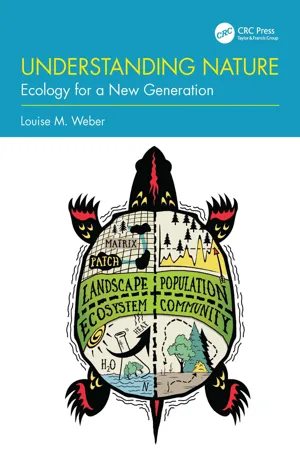
- 354 pages
- English
- ePUB (mobile friendly)
- Available on iOS & Android
About this book
Understanding Nature is a new kind of ecology textbook: a straightforward resource that teaches natural history and ecological content, and a way to instruct students that will nurture both Earth and self. While meeting the textbook guidelines set forth by the Ecological Society of America, Understanding Nature has a unique ecotherapy theme, using a historical framework to teach ecological theory to undergraduates.
This textbook presents all the core information without being unnecessarily wordy or lengthy, using simple, relatable language and discussing ecology in ways that any student can apply in real life. Uniquely, it is also a manual on how to improve one's relationship with the Earth. This is accomplished through coverage of natural history, ecology, and applications, together with suggested field activities that start each chapter and thinking questions that end each chapter. The book includes traditional ecological knowledge as well as the history of scientific ecological knowledge.
Understanding Nature teaches theory and applications that will heal the Earth. It also teaches long-term sustainability practices for one's psyche. Professor Louise Weber is both an ecologist and a certified ecopsychologist, challenging ecology instructors to rethink what and how they teach about nature. Her book bridges the gap between students taking ecology to become ecologists and those taking ecology as a requirement, who will use the knowledge to become informed citizens.
Frequently asked questions
- Essential is ideal for learners and professionals who enjoy exploring a wide range of subjects. Access the Essential Library with 800,000+ trusted titles and best-sellers across business, personal growth, and the humanities. Includes unlimited reading time and Standard Read Aloud voice.
- Complete: Perfect for advanced learners and researchers needing full, unrestricted access. Unlock 1.4M+ books across hundreds of subjects, including academic and specialized titles. The Complete Plan also includes advanced features like Premium Read Aloud and Research Assistant.
Please note we cannot support devices running on iOS 13 and Android 7 or earlier. Learn more about using the app.
Information
Table of contents
- Cover
- Half Title
- Title Page
- Copyright Page
- Dedication
- Table of Contents
- Acknowledgments
- About the Author
- 1 Introduction
- 2 We stand on their shoulders
- 3 Biomes, life forms, and ecoregions
- 4 Biomes: Tundra and taiga
- 5 Biomes: Grassland
- 6 Biomes: Shrubland, thickets, and desert
- 7 Biomes: Savanna and forest
- 8 Why are biomes where they are?
- 9 Why are individual species where they are?
- 10 Introduction to evolution: The modern synthesis
- 11 Advances in microevolution, molecular evolution, and evo-devo
- 12 An autobiography of the Earth
- 13 Introduction to statistics
- 14 Population ecology basics
- 15 Population ecology’s profound questions
- 16 Community ecology basics
- 17 Theory in community ecology/competition
- 18 Predation
- 19 Succession
- 20 Ecosystem ecology basics
- 21 Energy
- 22 Matter
- 23 Ecosystem regulation
- 24 Landscape ecology
- 25 Wildlife management and habitat ecology
- 26 Wildlife management for temperate farms and ranches
- 27 Wildlife management in temperate forests
- 28 Conservation biology
- 29 Restoration ecology
- 30 Aquatic ecology
- 31 New perspectives in biogeography
- 32 Wicked problems
- 33 Epilogue – the evolution of an idea
- Index